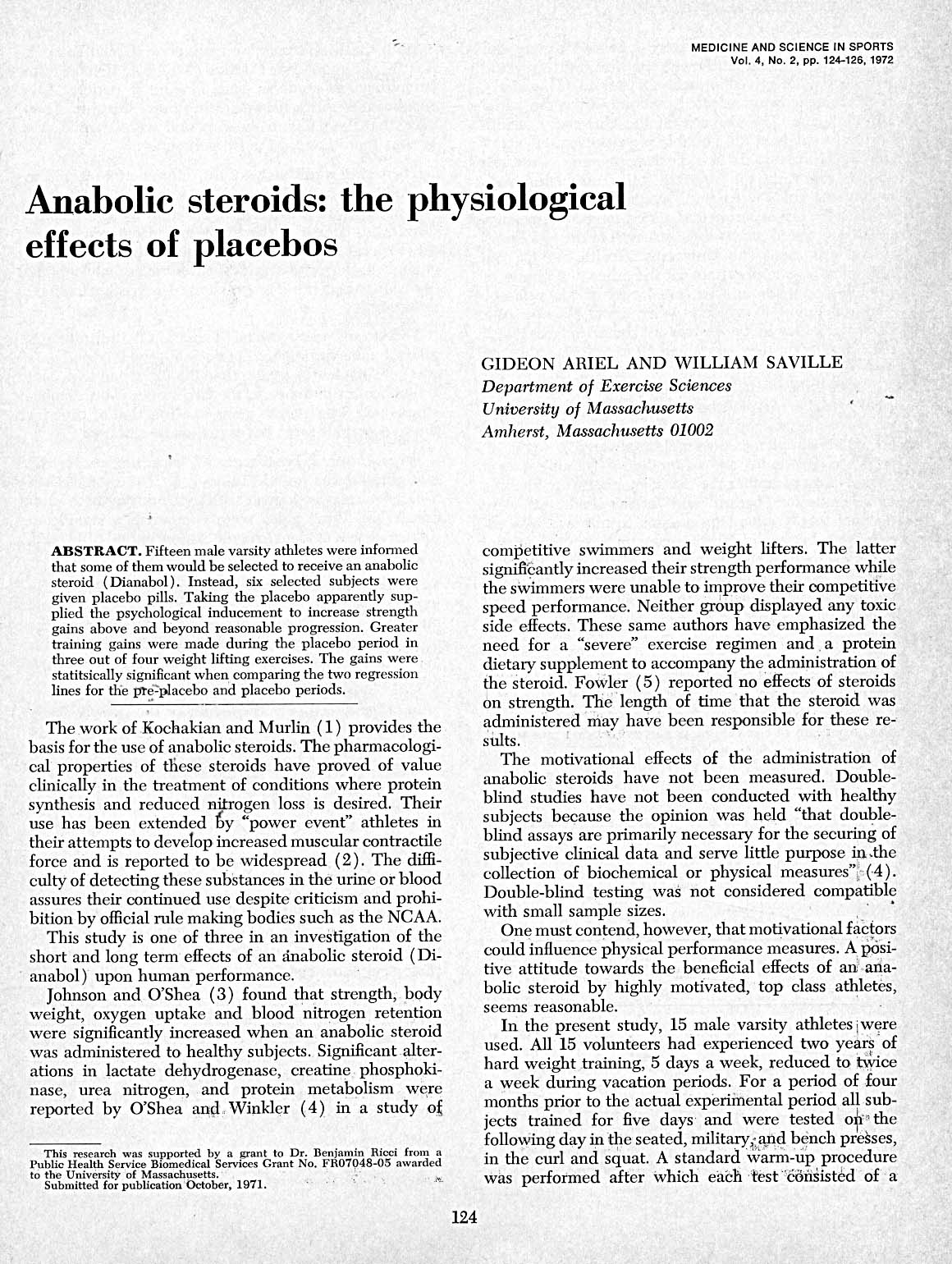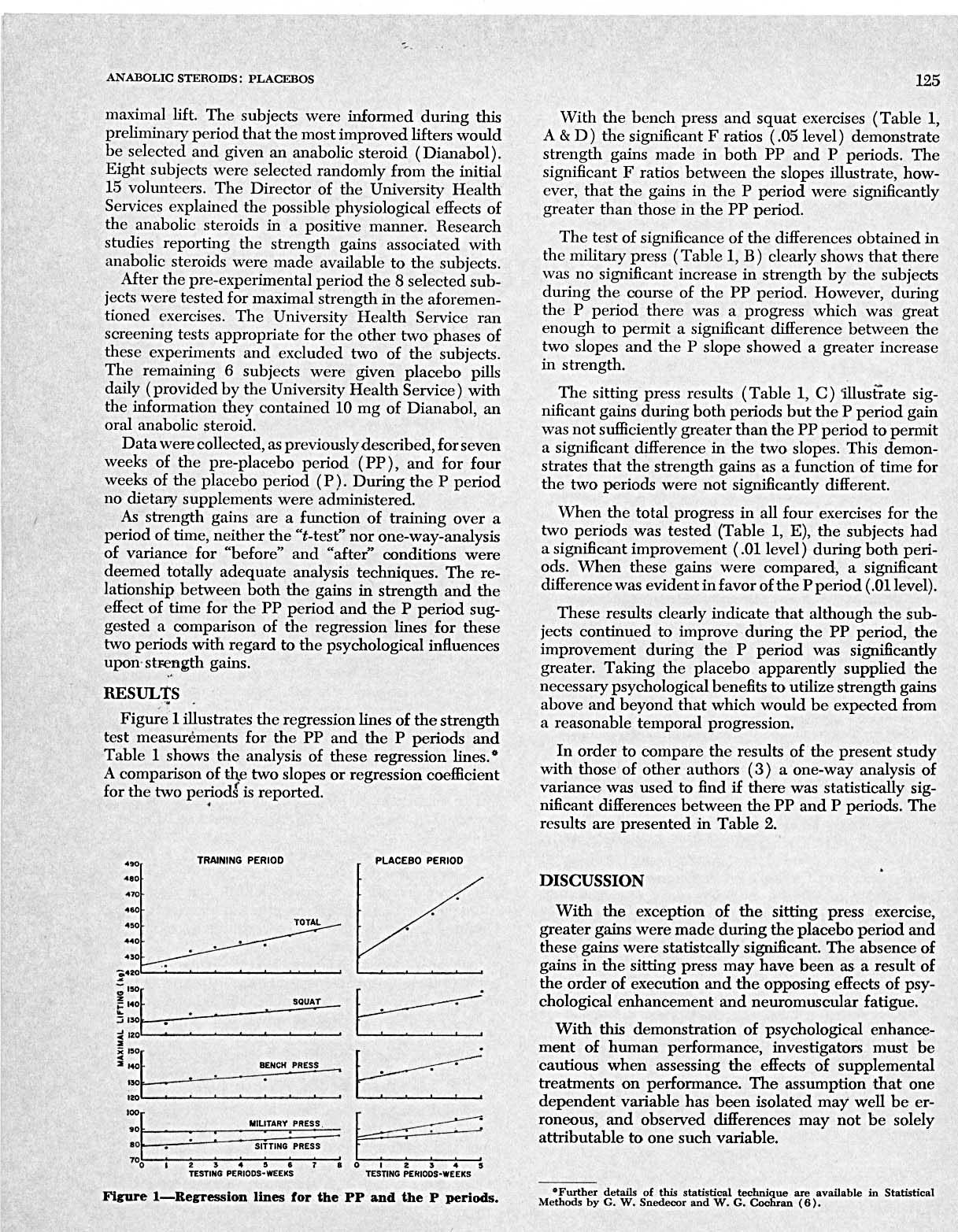Anabolic steroids: the physiological effects of placebos
This study is one of three in an investigation of the short and long term effects of an anabolic steroid (Dianabol) upon human performance
By Gideon Ariel in Medicine and Science in Sports on Tuesday, May 23, 1972
Anabolic Steroids: The Physiological Effects of Placebos
This 1972 study, published in Medicine and Science in Sports, investigates the psychological effects of placebo anabolic steroids on male varsity athletes. The study found that athletes who believed they were taking anabolic steroids (Dianabol), but were actually given placebo pills, showed significant strength gains above normal progression. This was evident in three out of four weight lifting exercises. The study suggests that the psychological belief in the benefits of anabolic steroids can significantly influence physical performance measures. The researchers caution that this psychological enhancement should be considered when assessing the effects of supplemental treatments on performance.
Tip: use the left and right arrow keys
MEDICINE AND SCIENCE IN SPORTS Vol. 4, No. 2, pp. 124-126. 1972
Anabolic steroids: the physiological
effects of placebos
ABSTRACT. Fifteen male varsity athletes were informed that some of them would be selected to receive an anabolic steroid (Dianabol). Instead, six selected subjects were given placebo pills. Taking the placebo apparently supplied the psychological inducement to increase strength gains above and beyond reasonable progression. Greater training gains were made during the placebo period in three out of four weight lifting exercises. The gains were statitsically significant when comparing the two regression lines for the pte-placebo and placebo periods.
The work of Kochakian and Murlin (1) provides the basis for the use of anabolic steroids. The pharmacological properties of these steroids have proved of value clinically in the treatment of conditions where protein synthesis and reduced nitrogen loss is desired. Their use has been extended b`y "power event" athletes in their attempts to develop increased muscular contractile force and is reported to be widespread (2). The dieculty of detecting these substances in the urine or blood assures their continued use despite criticism and prohibition by official rule making bodies such as the NCAA.
This study is one of three in an investigation of the short and long term effects of an anabolic steroid (Dianabol) upon human performance.
Johnson and O'Shea (3) found that strength, body weight, oxygen uptake and blood nitrogen retention were significantly increased when an anabolic steroid was administered to healthy subjects. Significant alterations in lactate dehydrogenasc, creatine phosphokinasc, urea nitrogen, and protein metabolism were reported by O'Shea and Winkler (4) in a study o�
This research was supported by a grant to Dr. Benjamin Ricci from a Public Health Service Biomedical Services Grant No. FR07048-05 awarded to the University of Massachusetts.
Submitted for publication October, 1971.
GIDEON AHIEL AND WILLIAM SAVILLE
Department of Exercise Sciences University of Massachusetts Amherst, Massachusetts 01002
competitive swimmers and weight lifters. The latter significantly increased their strength performance while the swimmers were unable to improve their competitive speed performance. Neither group displayed any toxic side effects. These same authors have emphasized the need for a "severe" exercise regimen and a protein dietary supplement to accompany the administration of the steroid. Fowler (5) reported no effects of steroids on strength. The length of time that the steroid was administered may have been responsible for these results.
The motivational effects of the administration of anabolic steroids have not been measured. Doubleblind studies have not been conducted with healthy subjects because the opinion was held "that doubleblind assays arc primarily necessary for the securing of subjective clinical data and serve little purpose in the collection of biochemical or physical measures" (4). Double-blind testing was not considered compatible with small sample sizes.
One must contend, however, that motivational factors could influence physical performance measures. A positive attitude towards the beneficial effects of an anabolic steroid by highly motivated, top class athletes, seems reasonable.
In the present study, 15 male varsity athletes ; were used. All 15 volunteers had experienced two years of hard weight training, 5 days a week, reduced to twice a week during vacation periods. For a period of four months prior to the actual experimental period all subjects trained for five days and were tested o~ , the following day in the seated, military,; and bench presses, in the curl and squat. A standard warns-up procedure was performed after which each test "consisted of a
124
ANABOLIC STEROIDS : PLACEBOS
125
maximal lift. The subjects were informed during this preliminary period that the most improved lifters would be selected and given an anabolic steroid (Dianabol ). Eight subjects were selected randomly from the initial 15 volunteers. The Director of the University Health Services explained the possible physiological effects of the anabolic steroids in a positive manner. Research studies reporting the strength gains associated with anabolic steroids were made available to the subjects.
After the pre-experimental period the 8 selected subjects were tested for maximal strength in the aforementioned exercises. The University Health Service ran screening tests appropriate for the other two phases of these experiments and excluded two of the subjects. The remaining 6 subjects were given placebo pills daily (provided by the University Health Service) with the information they contained 10 mg of Dianabol, an oral anabolic steroid.
Data were collected, as previously described, for seven weeks of the pre-placebo period (PP), and for four weeks of the placebo period (P). During the P period no dietary supplements were administered.
As strength gains are a function of training over a period of time, neither the "t-test" nor one-way-analysis of variance for "before" and "after" conditions were deemed totally adequate analysis techniques. The relationship between both the gains in strength and the effect of time for the PP period and the P period suggested a comparison of the regression lines for these two periods with regard to the psychological influences upon strength gains.
RESULTS
Figure 1 illustrates the regression lines of the strength test measurements for the PP and the P periods and Table 1 shows the analysis of these regression lines." A comparison of the two slopes or regression coefficient for the two periods is reported.
Figure 1-Regression lines for the PP and the P periods.
With the bench press and squat exercises (Table 1, A & D) the significant F ratios (.05 level) demonstrate strength gains made in both PP and P periods. The significant F ratios between the slopes illustrate, however, that the gains in the P period were significantly greater than those in the PP period.
The test of significance of the differences obtained in the military press (Table 1, B) clearly shows that there was no significant increase in strength by the subjects during the course of the PP period. However, during the P period there was a progress which was great enough to permit a significant difference between the two slopes and the P slope showed a greater increase in strength.
The sitting press results (Table 1, C) 'illustrate significant gains during both periods but the P period gain was not sufficiently greater than the PP period to permit a significant difference in the two slopes. This demonstrates that the strength gains as a function of time for the two periods were not significantly different.
When the total progress in all four exercises for the two periods was tested (Table 1, E), the subjects had a significant improvement (.01 level) during both periods. When these gains were compared, a significant difference was evident in favor of the P period (.01 level).
These results clearly indicate that although the subjects continued to improve during the PP period, the improvement during the P period was significantly greater. Taking the placebo apparently supplied the necessary psychological benefits to utilize strength gains above and beyond that which would be expected from a reasonable temporal progression.
In order to compare the results of the present study with those of other authors (3) a one-way analysis of variance was used to find if there was statistically significant differences between the PP and P periods. The results are presented in Table 2.
DISCUSSION
With the exception of the sitting press exercise, greater gains were made during the placebo period and these gains were statistcally significant. The absence of gains in the sitting press may have been as a result of the order of execution and the opposing effects of psychological enhancement and neuromuscular fatigue.
With this demonstration of psychological enhancement of human performance, investigators must be cautious when assessing the effects of supplemental treatments on performance. The assumption that one dependent variable has been isolated may well be erroneous, and observed differences may not be solely attributable to one such variable.
"Further details of this statistical technique are available in Statistical Methods by C. W. Snedecor and W. G. Cochran (6).
490 400 470
TRAINING PERIOD
460 450 440 430
:420
0 ISO
; 140 J 130
120 3
x I50
i 140 BENCH PRESS 130
ISO
PLACEBO PERIOD
TOTAL
SQUAT
100
90 so
MILITARY PRESS. SITTING PRESS
2 3 4 5 6 7 TESTING PERIODS-WEEKS
e
O 1 2 3 4 3
TESTING PERIODS-WEEKS
126 MEDICINE AND SCIENCE IN SPORTS
TABLE 1. A comparison of regression lines representing strength measurements in a training and a placebo period.
d.f. Reg. Coef. Deviations from Reg. M.S. F-ratio
d.f. S.S.
(A) Exercise: Bench press
Within 6 .95 5 7.82 1.56 16.02(1, 5)*
Training (PP)
Placebo (P) 4 3.28 3 30.67 10.22 10.54(1, 3)*
Sum 8 38.48 4.81
Pooled, W. 10 .73 9 78.74 8.75 28.97(1, 9)**
Difference between slopes: 1 40.25 40.25 8.37(1, 8)*
(B) 6 .09 Exercise: Military press .46 .54(1, 5)
Within
- Training (PP)
5 2.30
Placebo (P) 4 2.54 3 5.75 1.92 33.59(1, 3)*
Sum 8 8.05 1.01
Pooled, W. 10 .73 9 52.02 5.78 12.97(1-, 9)**
Difference between slopes: 1 43.98 43.98 43.76(1, 8)**
(C) 6 .84 Exercise: Sitting press 1.09 18.19(1, 5)**
Within 5 5.44
Training (PP)
Placebo (P) 4 1.44 3 2.13 .71 29.23(1, 3)*
Sum 8 7.57 .95
Pooled, W. 10 1.00 9 10.20 1.13 81.12(1, 9)**
Difference between slopes: 1 2.64 2.64 2.79(1, 8)
(D) 6 1.24 Exercise: Squat 1.45 29.95(1, 5)**
Within 5 7.24
Training (PP)
Placebo (P) 4 2.80 3 17.65 5.88 13.35(1, 3)*
Sum 8 24.89 3.11
Pooled, W. 10 1.65 9 42.79 4.75 35.40(1, 9)**
Difference between slopes: 1 17.90 17.90 5.75(1, 8)*
(E) 6 3.13 All exercises combined 5.93 46.10(1, 5)**
Within 5 29.67
Training (PP)
Placebo (P) 4 10.06 3 72.95 24.32 41.65(1, 3)**
Sum 8 102.62 12.83
Pooled, W. 10 4.95 9 457.38 50.81 43.40(1, 9)**
Difference between slopes: 1 354.71 354.71 27.65(1,8)**
*F-ratio significant at the .05 level of confidence. **F-ratio significant at the .01 level of confidence.
TABLE 2. Effects of placebo (steroid) treatment on strength measured, in kilograms, by maximum weight lifting.
Exercise Training Placebo Mean
period (PP) period (P) diff.
Bench P. Before After Diff. Before After Diff. 8.74*
133.32 137.86 4.54 137.86 151.14 13.28
Military P. 88.27 89.00 .73 89.00 96.59 7.59 6.86**
Sitting P. 82.58 84.85 2.27 84.85 90.15 5.30 3.03
Squat 134.85 137.50 2.65 137.50 156.44 18.94 16.29**
*Significant at the .05 level of confidence. **Significant at the .01 level of confidence.
REFERENCES
KocHAJUAN, C. D. AND J. R. MURLIN. J. Nutrit. 10:437,1935. 5. FowLER, W. M., G. W. GARDNER AND G. H. EYsmoas.
COBLEY, J. Track and Field News, May 16, 1971. 1. Appl. Physiol. 20:1038, 1969.
JosiNsoN, L. C. AND J. P. O'SIIEA. Science. 164:957, 1969. 6. SNEDECOR, G. W. AND W. G. COCHRAN. STATISTICAL
O'SHEA, J. P. AND W. WINYLER. Nutrition Report Inter- METHODS. The Iowa State University Press, Ames, Iowa,
national 2, No. 6, 351, 1970. pp. 432-436, 1967.



